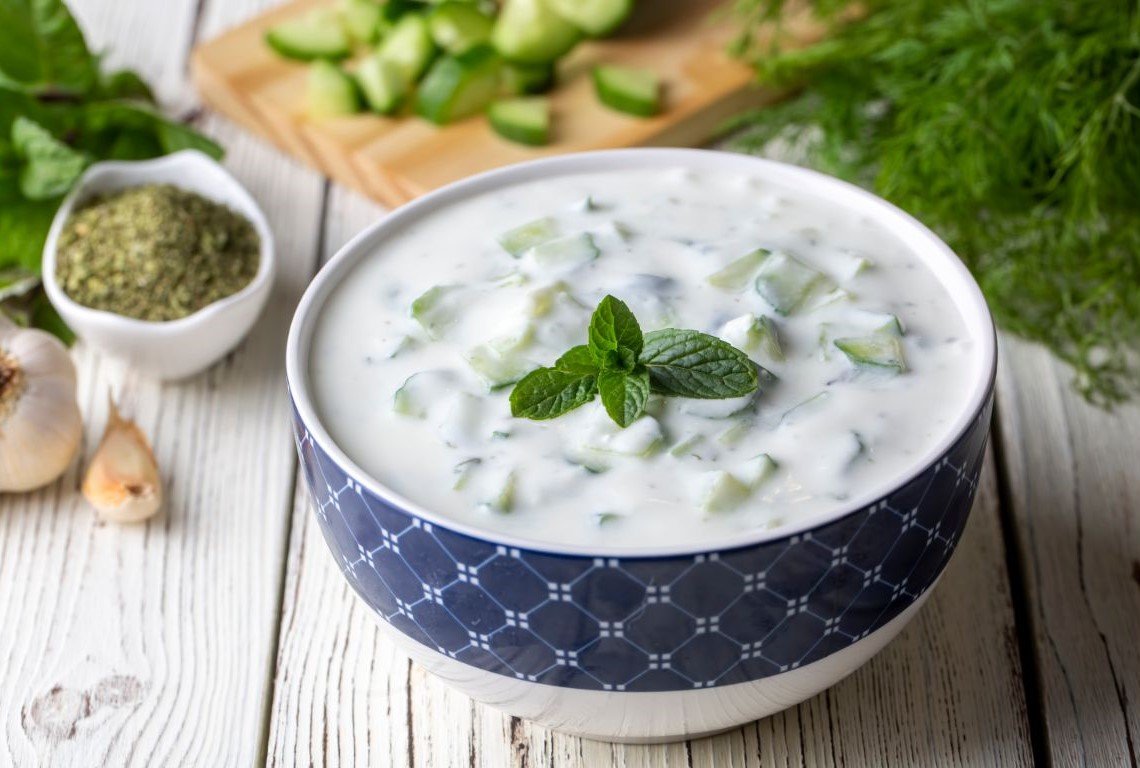Introduction to Tzatziki
Tzatziki is a traditional Greek dip that has gained popularity across a wide range of cuisines due to its refreshing taste and versatile nature. Primarily made from strained yogurt, cucumber, garlic, and an array of herbs, tzatziki sauce offers a delightful blend of flavors that can enhance various dishes. Its origins can be traced back to the Mediterranean region, where it has been consumed for centuries as both a condiment and a side dish. The use of yogurt in tzatziki not only adds richness but also contributes to the dip’s creamy texture, making it a favorite accompaniment to grilled meats and vegetables.
This delectable sauce is also celebrated for its nutritional benefits, making it a sought-after choice for health-conscious eaters. The main ingredient, yogurt, is a great source of protein, calcium, and probiotics that promote gut health. Cucumbers add a refreshing crunch while providing essential vitamins and hydration, making homemade tzatziki a light yet satisfying option. The inclusion of garlic and herbs, such as dill or mint, not only elevates the flavor but also adds health benefits associated with these ingredients, such as anti-inflammatory properties and antioxidants.
Furthermore, tzatziki’s versatility allows it to be used in numerous ways. It works wonderfully as a dip for pita bread, fresh vegetables, or falafel, and can also serve as a sauce for gyros or grilled chicken. Given its wide array of applications, homemade tzatziki is a perfect addition to various meals, complementing Mediterranean dishes and beyond. As we delve further into the preparation of this iconic sauce, you will discover not just its significance in culinary traditions but also the simple steps to create your own delicious tzatziki at home.
Ingredients Needed for Tzatziki

To prepare a delightful homemade tzatziki sauce, you will require a carefully selected array of ingredients that not only contribute to its distinctive flavor but also impact its overall quality. The primary component is Greek yogurt, which serves as the base for this dip. Opt for a full-fat variety for a creamier texture and richer taste, or choose a low-fat option if you prefer a lighter dish. Ensure that the yogurt is of high quality, as this will significantly affect the final flavor of your tzatziki.
Another essential ingredient is cucumber. For the best results, select fresh, firm cucumbers, preferably English cucumbers, as they possess fewer seeds and a thinner skin, reducing bitterness. If you are working with regular cucumbers, peeling them may enhance the taste. The cucumbers should be grated and drained of excess moisture to prevent the tzatziki from becoming too watery.
Fresh garlic is also crucial, adding a zing and depth to the dip. Adjust the quantity based on your preference for garlic intensity. Dill and mint are common herbs used in authentic tzatziki sauce, each providing a refreshing backdrop. When using fresh herbs, always aim for high-quality, vibrant leaves. If fresh herbs are unavailable, dried alternatives can be used in smaller quantities.
Salt and black pepper are necessary for seasoning, and you may also consider adding a touch of olive oil to enhance the texture and flavor profile. For those with dietary restrictions, substitutions can be made; for instance, a dairy-free yogurt can be used to create a vegan version of tzatziki. Optional ingredients such as lemon juice or vinegar can further elevate the flavor, making the dip more tangy and appealing. Each ingredient plays an integral role in crafting a balanced homemade tzatziki that is sure to be a hit at any gathering.
Step-by-Step Preparation Instructions

Making delicious homemade tzatziki sauce begins with the essential ingredient: cucumber. Start by selecting a fresh cucumber, preferably a European or Persian variety, as they have fewer seeds and a thinner skin. Begin by thoroughly washing the cucumber and then finely grating it using a box grater or food processor. Once grated, place the cucumber in a fine-mesh strainer or cheesecloth to remove excess moisture. For best results, sprinkle a pinch of salt over the grated cucumber and allow it to sit for about ten minutes. This salting technique helps draw out moisture, ensuring your tzatziki has the ideal consistency.
After ten minutes, press the cucumber to remove any remaining liquid, then transfer it to a mixing bowl. Next, you will need to incorporate yogurt into your tzatziki. You can use either regular or Greek yogurt, depending on your preference for thickness. Aim for about one cup of yogurt for every cucumber you prepare. Mix the drained cucumber with the yogurt and stir until fully combined.
To achieve the classic tzatziki flavor, it is essential to add minced garlic, lemon juice, and fresh herbs. Typically, one to two cloves of garlic will suffice, though you can adjust according to taste. Squeeze in the juice from half a lemon, which offers a refreshing acidity that balances the creaminess of the yogurt. Chopped fresh dill or mint contributes a vibrant flavor and aroma, so add approximately two tablespoons of whichever herb you prefer. Season the mixture with additional salt and pepper to taste. For those looking to experiment, consider introducing spices like cumin or cayenne, or even finely diced vegetables such as radishes or bell peppers.
Mix all ingredients thoroughly until you achieve a smooth and even consistency. Let the tzatziki rest in the refrigerator for at least one hour before serving, allowing the flavors to meld beautifully. Now, you have a delightfully refreshing homemade tzatziki sauce ready to elevate your meals!
Serving Suggestions and Pairing Ideas
Homemade tzatziki is a versatile condiment that can enhance a variety of dishes, making it an excellent addition to your culinary repertoire. To fully appreciate its refreshing flavor and creamy texture, consider serving tzatziki as a dip alongside warm pita bread or an assortment of fresh vegetables. Carrot sticks, cucumber slices, and bell pepper strips complement the tanginess of the tzatziki sauce beautifully, providing a colorful and healthy appetizer platter.
In addition to serving tzatziki as a dip, it can also be utilized as a sauce to elevate grilled meats. When paired with lamb, chicken, or pork, tzatziki adds a refreshing contrast to the rich and smoky flavors imparted by grilling. For a delectable experience, drizzle tzatziki over kebabs or serve alongside grilled meat dishes for an extra burst of flavor that enhances each bite.
Homemade tzatziki can also be seamlessly incorporated into a variety of dishes such as gyros, where it plays a crucial role in balancing the spices of the meat and freshness of the vegetables. Additionally, consider using tzatziki to dress salads, offering a unique twist that marries veggies and grains with its creamy texture. Its adaptability depends on the cuisine you are exploring, making tzatziki an exceptional component in Mediterranean-inspired meals.
To ensure that your homemade tzatziki remains fresh and flavorful, it is important to store it correctly. Seal the tzatziki in an airtight container and refrigerate it, where it can last for up to a week. This makes it an ideal choice for meal prep, allowing you to whip up quick lunches or snacks without compromising on taste. By employing these serving suggestions and pairing ideas, you can elevate your dishes with the addition of tzatziki, creating delightful culinary experiences. In conclusion, homemade tzatziki is a delightful companion to a myriad of dishes, enriching their flavors while adding a touch of freshness.


